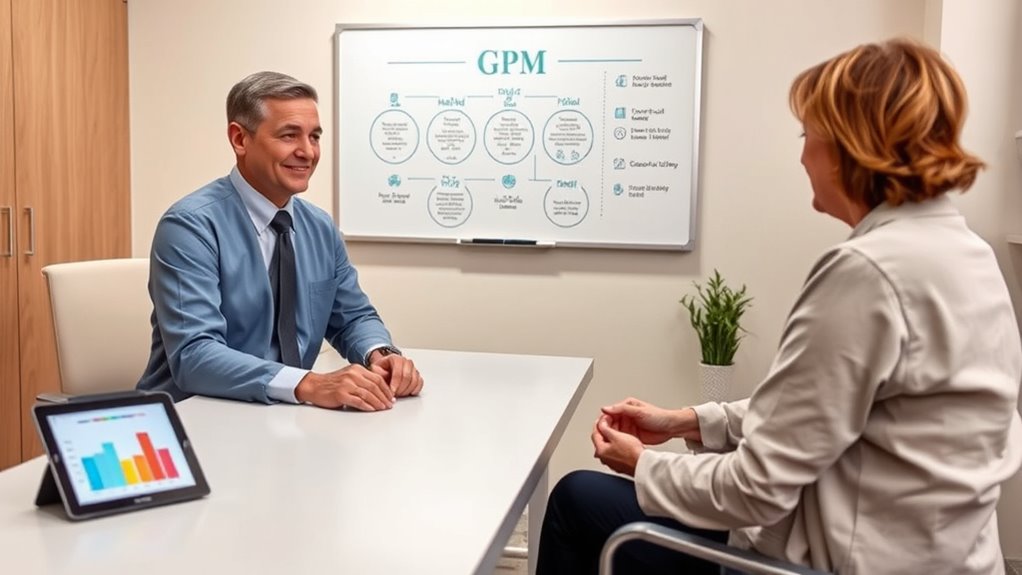General Psychiatric Management (GPM) is an evidence-based approach for treating borderline personality disorder that focuses on symptom management, establishing strong therapeutic relationships, and teaching practical strategies for daily life. It emphasizes understanding relationship dynamics, managing crises, and promoting recovery through tailored interventions. GPM is flexible and collaborative, helping patients develop resilience and regain stability over time. If you continue exploring, you’ll discover how GPM can be integrated into effective treatment plans.
Key Takeaways
- GPM is an evidence-based, flexible treatment for borderline personality disorder focusing on symptom management and relationship dynamics.
- It emphasizes building trust through validation, active listening, and a “not-knowing” stance to foster safety and engagement.
- GPM manages crises with safety planning, early warning sign identification, and collaborative step-by-step intervention strategies.
- The approach promotes real-life problem solving, psychoeducation, and practical support to enhance stability and recovery.
- Clinicians can access specialized training, resources, and ongoing education to effectively implement GPM in practice.
What Is General Psychiatric Management (GPM)?

General Psychiatric Management (GPM) is an evidence-based, practical treatment approach designed for individuals with borderline personality disorder (BPD). As a treatment model, it emphasizes symptom management, psychoeducation, and setting realistic goals to improve daily functioning.
GPM was developed by John Gunderson and Lois W. Choi-Kain to offer a flexible alternative to specialized therapies like DBT, suitable for various settings. The approach addresses common unhelpful interventions, such as repeated hospitalizations and complex medication regimens.
GPM is grounded in the interpersonal hypersensitivity model of BPD, which highlights the importance of understanding relationship dynamics and building a supportive network. Research shows that GPM can produce significant reductions in self-injury, depression, and anger, making it a valuable evidence-based option for managing BPD. Additionally, GPM incorporates residency requirements and legal considerations relevant to mental health treatment settings.
Core Principles and Theoretical Foundations of GPM

At the heart of GPM are its core principles and the theoretical framework that guides its practices. It’s rooted in understanding borderline personality disorder as linked to interpersonal hypersensitivity, which makes patients highly reactive to perceived threats.
GPM centers on understanding BPD as rooted in interpersonal hypersensitivity and reactivity to perceived threats.
You focus on treatment principles that emphasize symptom management and realistic goal setting, helping patients develop healthier relationships. GPM encourages relationship-focused insights, guiding clinicians to understand and navigate patients’ sensitivities without reinforcing unhelpful patterns.
It models a “not-knowing” stance, promoting reflection and healthy relationship development outside therapy. The approach prioritizes practical, evidence-based strategies over complex medication regimens or repeated hospitalizations.
Recognizing that most BPD patients improve naturally over time, GPM offers a flexible, collaborative, and accessible framework to support lasting functional improvements.
How GPM Addresses Borderline Personality Disorder

You’ll find that GPM uses practical strategies to help stabilize BPD symptoms by focusing on real-life problem-solving and setting achievable goals. The approach emphasizes building a strong, trusting relationship to support your natural recovery process. Additionally, understanding the importance of emotional regulation can further enhance treatment outcomes by helping individuals manage intense feelings more effectively. Developing coping skills is also a key component in managing symptoms and preventing crises. Incorporating behavioral interventions can provide additional tools to promote healthier responses and reduce impulsivity over time. Recognizing the role of patient education can empower individuals to better understand and manage their condition, leading to improved long-term stability. Moreover, awareness of state tax implications can inform financial planning for sustained treatment and support during recovery.
Focus on Practical Strategies
Practical strategies lie at the heart of GPM’s approach to managing Borderline Personality Disorder, emphasizing real-life problem-solving over intensive therapy models. You focus on symptom management and setting achievable goals that promote stability in relationships, work, and routines. GPM teaches you to use psychoeducation to understand your symptoms and reduce stigma, fostering hope. When crises like suicidality or self-harm occur, clear evidence-based guidelines ensure your safety. Building a strong therapeutic alliance is essential—active listening, validation, and curiosity help you trust your clinician and stay engaged. The table below highlights key aspects of GPM’s practical approach: compassionate care. This method also emphasizes structured treatment plans that adapt to individual needs, promoting consistency and progress. Additionally, understanding self management techniques can empower you to handle daily challenges more effectively. Recognizing the importance of therapeutic skills further supports sustained recovery and resilience.
Emphasizes Relationship Building
Building a strong, collaborative therapeutic relationship is central to GPM’s approach in addressing Borderline Personality Disorder. You focus on relationship building by actively listening, offering validation, and maintaining a curious, “not-knowing” stance. This helps foster trust, which is essential for emotional stability. Incorporating mental clarity techniques can further enhance your ability to engage authentically with others. GPM models healthy interpersonal behaviors outside therapy, giving you corrective emotional experiences that promote healthier patterns. The approach emphasizes understanding your interpersonal sensitivities and developing more adaptive ways of relating. It encourages you to build a network of multiple, less intense relationships, reducing dependency and emotional volatility. By prioritizing genuine connection and understanding, GPM aims to decrease interpersonal crises and strengthen trust, ultimately supporting your journey toward emotional stability and healthier relationships. Developing interpersonal skills can also help you navigate complex social situations more effectively, reinforcing the progress made in therapy. Additionally, understanding emotional regulation strategies can help you manage intense feelings and reduce impulsive reactions, further supporting your growth. Recognizing the importance of attachment patterns can also provide insight into your relational tendencies and facilitate healing processes. Understanding emotional dysregulation is vital for recognizing and managing your emotional responses more effectively, which is a core aspect of BPD treatment.
Supports Natural Recovery Process
Supporting the natural recovery process is a central aspect of GPM’s approach to treating Borderline Personality Disorder. You’re encouraged to view recovery as a natural course, where resilience and self-management are key.
GPM emphasizes realistic goal setting and symptom management, helping you build stability without overreliance on intensive interventions. By addressing unhelpful practices like repeated hospitalizations, it promotes your capacity for self-healing and resilience.
Psychoeducation and relationship-focused insights reinforce your understanding of the recovery process, empowering you to recognize progress in your natural healing journey. Additionally, research indicates that incorporating portable recovery tools can enhance self-management outside clinical settings, supporting sustained progress over time.
Evidence shows that GPM yields outcomes comparable to specialized therapies like DBT, especially for those with comorbidities, by harnessing your body’s and mind’s innate ability to recover over time. Furthermore, understanding the resources and tools available can help you develop personalized strategies for ongoing self-care and resilience. Incorporating self-management strategies can further empower you to maintain stability independently and foster long-term recovery.
Practical Components of GPM in Clinical Practice

You’ll find that building strong therapeutic relationships is central to GPM, fostering trust through curiosity and validation.
Managing crises like suicidality and self-harm with clear, pragmatic strategies helps keep patients safe and engaged.
Additionally, coordinating practical support such as housing and employment addresses real-life challenges that are essential for recovery.
Furthermore, understanding AI advancements can inform innovative approaches to mental health treatment, integrating emerging technologies to enhance patient care.
A comprehensive understanding of essential oils can also be incorporated into holistic care plans, supporting symptom management and overall well-being.
Building Therapeutic Relationships
Establishing a strong therapeutic relationship is a cornerstone of General Psychiatric Management, and it begins with demonstrating genuine curiosity and a “not-knowing” stance that encourages patients to reflect openly.
By showing empathy and validation, you foster trust and create a safe space for clinical engagement. Building rapport involves active listening and collaboration, making patients feel heard and respected.
Consistent, scheduled sessions reinforce the connection, while flexibility allows you to adapt to their evolving needs.
These relationship skills directly impact treatment adherence, symptom management, and functional improvement.
- Feelings of being truly understood and valued
- Confidence in sharing difficult thoughts
- Hope sparked by genuine connection
- Motivation to engage actively in their recovery
Managing Crises Effectively
How can clinicians effectively manage crises in General Psychiatric Management? Successful crisis management relies on proactive strategies like safety planning and de-escalation techniques.
You should quickly identify early warning signs and triggers for self-harm and suicidality, enabling prompt intervention. Establish clear communication, validate the patient’s feelings, and develop a collaborative, step-by-step action plan for crisis situations.
Maintaining regular contact through brief check-ins or remote communication reassures the patient and supports stabilization. The goal is to prioritize safety while balancing long-term functional goals, avoiding hospitalization unless absolutely necessary.
Coordinating Practical Support
Effective crisis management in General Psychiatric Management (GPM) depends not only on immediate safety strategies but also on addressing the practical needs that support long-term stability. You’ll engage in case management to help with housing, employment, and insurance, fostering independence.
Collaborating with your clinician, you’ll set achievable daily goals, promoting responsibility. Psychoeducation about BPD and co-occurring disorders will deepen your understanding, boosting your engagement.
Regular contact, through check-ins via phone or email, reinforces treatment and provides ongoing support. This approach emphasizes individualized care, blending practical support with psychotherapy and medication management for holistic stability.
- Feel empowered as you take control of your daily life
- Experience hope through steady progress and understanding
- Feel supported by a team invested in your growth
- Discover resilience in overcoming practical challenges
Training and Skills Development for GPM

Training and skills development for GPM are designed to quickly equip clinicians with practical tools for managing borderline personality disorder (BPD).
The education involves a one-day in-person course or an 8-hour online module focused on core clinical skills. You learn to build therapeutic relationships using a “not-knowing” stance that encourages patient reflection and reduces impulsivity.
The program emphasizes essential skills like case management, psychoeducation, and collaborative goal setting, tailored to diverse patient needs.
Interactive components, including group discussions, clinical vignettes, and video demonstrations, enhance your ability to apply management strategies effectively.
This training aligns with ABMS/ACGME competencies, ensuring you develop essential clinical communication, evidence-based practice, and patient care skills needed to implement GPM confidently.
Managing Coexisting Conditions and Medication Strategies

Building on your skills in managing borderline personality disorder with GPM, addressing coexisting conditions is a key step in ensuring thorough care. You’ll focus on organizing treatment strategies for comorbid disorders like mood, anxiety, or substance use issues to promote stability.
Prioritizing these conditions helps prevent crises and creates a safer foundation for BPD interventions. Medications, including psychotropic agents, are used judiciously according to APA guidelines to target specific symptoms, support stability, and enhance therapeutic progress.
Effective psychiatric management involves continuous assessment and coordination of treatment. You should feel empowered to:
- Recognize the importance of stabilizing comorbid disorders
- Use medications thoughtfully to support overall health
- Incorporate treatment strategies that prioritize safety
- Engage in ongoing evaluation for ideal stability
Engaging Families and Support Systems in GPM

How can involving families and support systems enhance the success of General Psychiatric Management for BPD?
By incorporating family involvement and support systems, you create a stronger foundation for stability. Psychoeducation helps families understand BPD, reducing misunderstandings and fostering empathy.
Family coaching improves communication, making it easier to navigate conflicts and crises. Support systems provide emotional stability, modeling healthy relationships and boundaries.
Clinicians emphasize crisis management strategies and relapse prevention, empowering families to respond effectively during challenging times.
Engaging families doesn’t require formal therapy sessions but focuses on educating and coaching them to reinforce treatment goals.
This approach promotes treatment adherence, reduces relapse rates, and creates a more supportive environment that encourages long-term stability for individuals with BPD.
Evidence of GPM Effectiveness and Clinical Outcomes

Research consistently shows that GPM is an effective treatment for individuals with Borderline Personality Disorder. Clinical outcomes demonstrate significant symptom improvement, helping you regain control over emotional instability and impulsivity.
Studies reveal many patients experience notable progress and functional gains, often leading to natural recovery over time. GPM is especially beneficial for those with comorbid disorders, reducing hospitalizations and crisis episodes.
Even after two years, outcomes remain comparable to more intensive therapies, making GPM a practical, cost-effective option.
You can feel hopeful knowing that:
- *Your symptoms can diminish, bringing peace to your life.*
- *Interpersonal relationships can improve, restoring connection.*
- *Recovery, though challenging, is achievable with persistent effort.*
- *Stability in work and daily life is within reach.*
Resources and Continued Learning Opportunities

If you’re interested in implementing General Psychiatric Management (GPM), there are accessible resources to help you develop your skills. The primary training is an 8-hour course offered by Harvard Medical School’s Continuing Education Programs, suitable for various mental health professionals. This course emphasizes evidence-based practice through interactive case discussions, video demonstrations, and clinical vignettes. It covers psychoeducation, managing suicidality, medication strategies, and setting realistic treatment goals. To support your professional development, explore additional clinical resources and psychiatry education opportunities. These programs foster ongoing learning and skill refinement. Below is a table outlining key resources:
| Resource Type | Description |
|---|---|
| Continuing Education | Courses like Harvard’s GPM training |
| Clinical Resources | Case studies, clinical guidelines, and tools |
| Training Programs | Workshops and online modules for skill building |
Frequently Asked Questions
What Is GPM Therapy?
You’re asking what GPM therapy is. It’s a practical, evidence-based approach designed to help manage symptoms and improve your daily functioning.
You’ll find it flexible, tailored to your needs, and focused on problem-solving, psychoeducation, and setting realistic goals.
GPM helps you build healthier relationships, reduce hospitalizations, and avoid complex medication routines by teaching you effective coping skills and fostering stability in outpatient care.
What Is GPM in Psychology?
You’re asking about GPM in psychology. It’s an approach that helps you manage mental health symptoms by focusing on understanding core issues like emotional dysregulation and relationship sensitivities.
GPM emphasizes psychoeducation, realistic goals, and practical strategies you can apply easily. It’s designed to be flexible and accessible, helping you recover naturally without intensive therapy.
It has been shown to be as effective as more specialized treatments for conditions like BPD.
What Is the GPM Model of Interpersonal Hypersensitivity?
Imagine your social world as a fragile glass, easily shattered by perceived threats. The GPM model of interpersonal hypersensitivity shows that people with BPD see neutral cues as dangerous, reacting emotionally like sparks igniting a fire.
You learn to recognize these reactions, validate feelings, and teach healthier responses. This helps lower their sensitivity, transforming the fragile glass into sturdy crystal, capable of withstanding social storms without breaking.
What Are the 3 C’s of BPD?
The 3 C’s of BPD are Crisis, Chronicity, and Contradictions. You’ll notice frequent emotional and behavioral emergencies, showing how the condition involves ongoing instability.
You’ll also see persistent, long-standing patterns that define the disorder, along with conflicting feelings and behaviors happening simultaneously.
Recognizing these helps you understand the core features of BPD, guiding you to adopt a flexible, compassionate approach that targets crises, stability, and internal conflicts effectively.
Conclusion
Think of GPM as a guiding compass on your mental health journey, helping you navigate complex challenges with confidence. By understanding its core principles and practical strategies, you can build a stronger, more stable foundation. Remember, just like a sturdy bridge connects two points, GPM connects you to better management and hope. Embrace these tools, stay engaged, and trust in the process—you’re capable of growth and resilience every step of the way.









